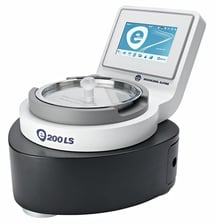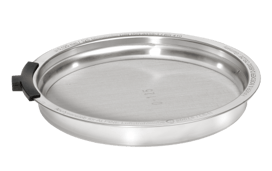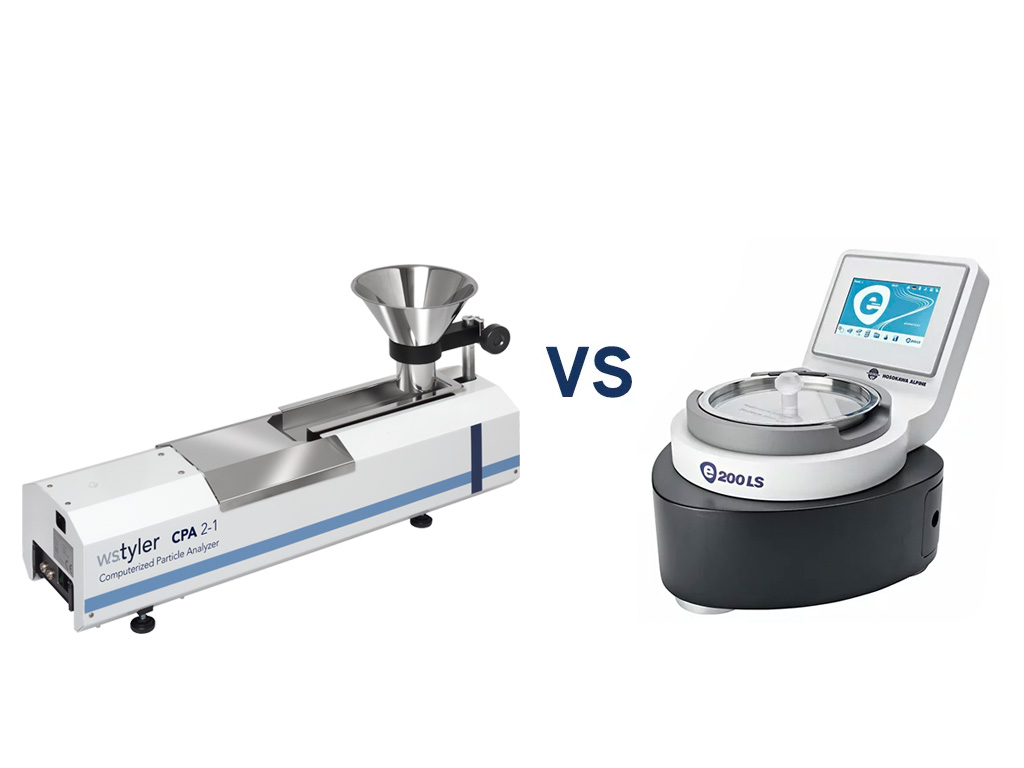Alpine Air Jet Sieve VS Computer Particle Analyzer (CPA)
Navigating the market for particle analysis equipment can be quite difficult. There are several different models that accomplish the same tasks in similar manners. Often, choosing the right machine is a matter of understanding your needs; however, sifting through the available information can require an expert.
W.S. Tyler has been a pioneer in the particle analysis industry for over 140 years. We offer a range of products to solve your particle analysis and sieving problems.
In this article, we will specifically discuss the differences and similarities between the Alpine Air Jet Sieve and the Computer Particle Analyzer (CPA) across the following categories:
- Material Type and Size
- Cost
- Noise Level
- Installation
- Ease of Operation
- Accuracy
- Time and Speed
- Data and Reporting
- Maintenance
What is the Alpine Air Jet Sieve?
The Alpine Air Jet Sieve e200LS is a vacuum-powered sieve. It is suited for specialized use in determining particle size and weighing batches.
It leverages a vacuum’s pressure to push air through a single screen from the bottom. The pressure causes the particles to crash against the sieve lid and break apart, allowing the undersized, no-longer-agglomerated particles to fall through the screen apertures.
The Alpine Air Jet Sieve is perfect for materials that have been tested and proven to be inconsistent through traditional sieving, based on parameters such as agglomerating particles or blinding screens.

For more information on the process and its specifications, check out the Alpine Air Jet.
What is the Computer Particle Analyzer?
The Computer Particle Analyzer (CPA) combines a powerful camera with computing technology to modernize the sieving process. Its photo-optical system has delivered accurate results with many materials in various industries.
The CPA is based on digital image processing. A high-resolution, digital line-scan camera captures free-falling particles against an LED lighting array. Up to 10,000 particles can be detected and analyzed every second.
The CPA is suited for applications where knowing the size and shape of the particle is important. It is also perfect for applications that call for in-line analysis.

For more information on the process and its specifications, check out the Computer Particle Analyzer.
Material Type and Size
Alpine Air Jet Sieve
The Alpine Air Jet Sieve is used for dry sieving fine, agglomerated particles, such as dirt, flour, or other substances that tend to stick together. It can separate particles down to 10 microns.
Computer Particle Analyzer
Because the CPA uses a camera to measure shadow projections, it can only analyze
non-agglomerated particles, such as dry aggregate material, gravel, plastic granules, potash, salt, sand, or wood chips. The camera will read multiple particles as one big particle if they stick together.
Cost
Alpine Air Jet
There are four different Alpine Air Jet software models. Depending on your needs, the e200LS can cost between $11,500.00 and $27,000.00. The biggest cost driver between the models is the inclusion of certain software. For example, the top-of-the-line e200LS Security saves all of its data to a network and leaves an electronic signature for auditing purposes. On the other hand, the e200LS Basic saves its data to the device and cannot be connected to a network, so some functions, like preset features, are unavailable.
NOTE: The ALPINE Air Jet e200 LS requires a Karcher vacuum to function. This vacuum is sold separately at an additional cost of $2,050.00.
Computer Particle Analyzer
The CPA is designed to run with a computer and customized software. Users can expect to pay at least $60,000 for the entire system due to its suite of technologies, its unique flexibility, and its highly efficient testing speed. A full breakdown on the cost of a Computer Particle Analyzer is available.

Noise Level
Alpine Air Jet Sieve
The Alpine Air Jet Sieve operates with an industrial vacuum cleaner (rated up to 69 dB), so some noise should be expected.
Computer Particle Analyzer
The CPA is quieter than the Alpine Air Jet e200LS. The main sources of noise include its vibratory feeder and particles dropping into the collection pan.
Installation
Alpine Air Jet Sieve
The installation depends on the model. If it’s an e200LS Basic, you can connect it to a scale, hook up the vacuum and power source, and start measuring. For a more advanced models, such as the e200LS Security, installation can last one day and require an on-site technician.
Computer Particle Analyzer
The CPA requires an on-site visit from a technician to install. At W.S. Tyler, our CPA expert comes to your facility for two days and trains the team on its capabilities, ensuring that customers are set up for long-term success.
Ease of Operation
Alpine Air Jet Sieve
Operating the Alpine Air Jet Sieve is a simple process once set up. Standard operating procedures can be programmed into most models of the e200LS. Once programmed, these procedures will guide operators through the sieving process, including override functions via a corresponding RFID chip.
 All software levels are capable of weighing and exporting results.
All software levels are capable of weighing and exporting results.
Computer Particle Analyzer
The CPA is a complex piece of equipment. It includes several high-tech components and specialized software to analyze the data from the sample.
After a two-day training program with a dedicated CPA specialist (included with the purchase of the device), users will be able to completely analyze material with the click of a button.
Accuracy and Repeatability
Alpine Air Jet Sieve
The Alpine Air Jet e200LS is extremely accurate given its ability to break apart agglomerated particles.
If fed the same materials and samples, the machine will yield reproducible results; however, undersized particles will fall through the sieve during your analysis. Eventually, these particles will be disposed via the vacuum. As a result, it is impossible to run the same sample material twice.
A peripheral device, such as the Cyclone, can re-collect fine materials after each test, remedying the issue.
Computer Particle Analyzer
Because the CPA is accompanied by a computer and software, it virtually eliminates human error, and the repeatability of your testing is guaranteed.The light handling of the product provides easy re-testing of materials without damaging them.
Time and Speed
Alpine Air Jet Sieve
The Alpine Air Jet Sieve minimizes human error and saves time with the eControl software. If a user wants to determine the particle size distribution (PSD), though, then the material must be run one sieve at a time.
There are two methods for calculating PSD:
The standard method involves placing the sample on the finest mesh and running the test. The remainder is then transferred to the next largest sieve, etc.
The Swiss method involves dividing the samples into an equal number of available size classes for sieves. The Swiss method takes longer and requires larger samples but is more exact than its counterpart.
Computer Particle Analyzer
The CPA owns a definite advantage in time and speed. The average length of a test is about three minutes, depending on particle and sample size.
It is important to note that the CPA yields results in a faster amount of time, making it an ideal choice in industries that require constant sieving.
Data and Reporting
Alpine Air Jet Sieve
The reporting on the e200LS is meticulous. Depending on the software level, users can have the results calculated and recorded in the Alpine Air Jet Sieve, have the test results printed for physical record-keeping, or have test results archived on an audit trail with electronic operator signatures.
Computer Particle Analyzer
The CPA is designed to give users more in-depth information. Due to its proprietary software, the CPA can even provide detailed information about the grain shapes of each particle that passes through the machine, unlike the Alpine Air Jet Sieve.
Maintenance
Alpine Air Jet Sieve
The e200LS recognizes screens by an RFID chip and informs users of scheduled cleanings. Screens have a longer lifespan because the machine is powered by air.
There is also a sieve-cleaning function. In this mode, a screen is placed over the air nozzle until the blinded apertures are dislodged. The sieve-cleaning function is intended for minor cleanings. Deep, thorough cleanings are still required as needed.
Ultimately, the Alpine Air Jet needs regular maintenance. W.S. Tyler recommends routine cleanings after testing. Ideally, the device would be cleaned after every use. At minimum, the device should be cleaned at the end of every day.
We also recommend that users schedule calibration (in accordance to industry standards), deep cleaning, and maintenance appointments in order to ensure the vacuum pressure is within acceptable tolerance and to diagnose filters or lines that need replaced.
Computer Particle Analyzer
Unlike the Alpine Air Jet Sieve, the CPA is virtually maintenance-free. When handled with care, these machines can run smoothly for years. The software might need to be updated, but that can be done remotely.
While rare, if something happens to the machine, it might be a technical problem that cannot be fixed in-house and must be sent back to the manufacturer.
To Sum It Up
Errors in particle analysis can cost your business time and money.
Both the Alpine Air Jet Sieve and Computer Particle Analyzer (CPA) are viable options for particle analysis, and W.S. Tyler has provided advice to clients on selecting both devices. The perfect device for you depends on your needs.
The Alpine Air Jet e200LS is a vacuum-powered sieve. It performs well with materials that can blind screens. It also excels with an agglomerating product that will not fall through screens. It is ideal for materials that have already been tested through traditional sieving and proved troublesome.
The Computer Particle Analyzer (CPA) is an ultra-accurate device best-suited for applications where speed of testing and more in-depth data and reporting are required. It is a truly modern solution to particle analysis.
If you have any questions about these machines or related devices, send us a message and our experts will be happy to help you.
Want all the latest industry trends and innovations sent directly to your inbox? Subscribe to our monthly newsletters today.
About Sam Badger
Sam has been a part of the W.S. Tyler family for three years and is currently a sales manager, overseeing our fabricated parts and customized filters. To help deliver best-in-class solutions, Sam works to bridge the gap between customers, both new and existing, and our engineering team. Additionally, Sam provides on-site servicing of the ALPINE Air Jet Sieve e200 LS, striving to learn your particle analysis operation to resolve any issues you encounter and ensure your equipment continues to produce accurate and repeatable results.


